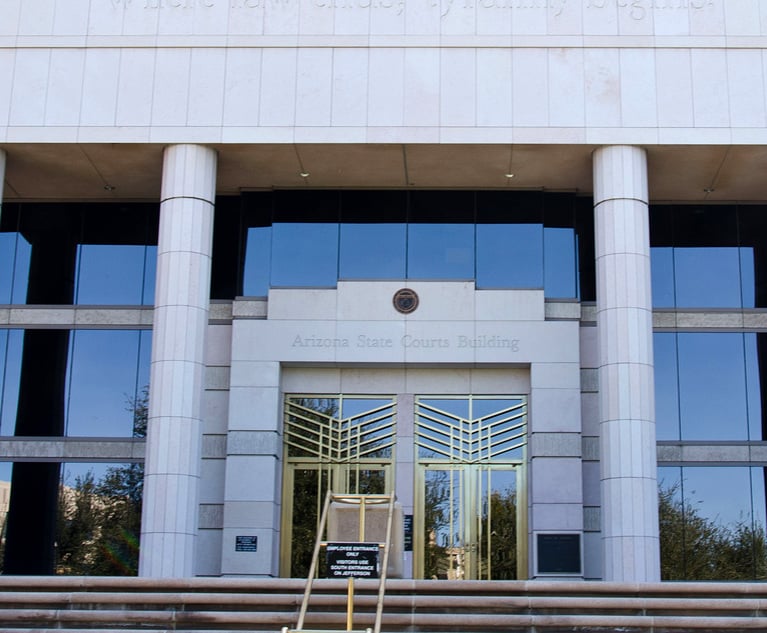Firm agreement
Clive Greenwood looks at whether restrictive covenants will survive when a law firm's partners vote to become a limited liability partnership
September 05, 2007 at 08:04 PM
7 minute read
Clive Greenwood looks at whether restrictive covenants will survive when a law firm's partners vote to become a limited liability partnership
The goodwill of a partnership is one of its most valuable assets and is commonly protected by restrictive covenants which, among other things, seek to prevent former partners from interfering in the relationships between the partnership and its customers and staff. But, can restrictive covenants in a partnership agreement be enforced against a former partner who retired from the partnership before its conversion to a limited liability partnership (LLP)? Possibly not, according to a recent decision of the Court of Appeal. It will depend upon the precise wording of the restrictive covenants in the partnership agreement.
In Nicholas Prescott v Dunwoody Sports Marketing [2007] the Court of Appeal held that the wording of a restrictive covenant in a partnership agreement prohibiting interference in the relationship between the partnership and its clients could not be enforced by the successor limited company after conversion. The court decided that the partnership ceased to have a relationship with clients when its entire business and assets were transferred to the limited company and there was nothing to be protected by the wording of the covenant.
Dunwoody Sports Marketing was a partnership that carried on business as marketing and advertising consultants for sports clients and Prescott was one of its partners. There was a written partnership agreement that included restrictive covenants restraining the activities of former partners in relation to the customers and staff of the partnership for a period of two years from the date the retiring individual ceased to be a partner.
The precise wording of the restrictive covenant provisions was central to the decision of the Court of Appeal and included the following:
l As regards clients – the outgoing partner was not permitted to "solicit business, entice clients or interfere with the relationship between the partnership and its customers …"
l As regards partners and staff – the outgoing partner was not permitted to solicit or offer employment to or enter into partnership with any person who was at any time during the twelve months prior to the retirement date "a partner in or employed by the partnership".
Prescott retired from the partnership on 6 May, 2005, and proceedings were subsequently issued against him seeking damages and permanent injunctions to enforce the restrictive covenants for two years from the date of his retirement on the basis that he had, both before and after his retirement, attempted to poach clients and staff and had successfully poached one member of staff.
Of significance in this case, unbeknown to Prescott or the solicitors acting for him at the time, the entire business and assets of the partnership were transferred to a limited company on 1 August, 2005, and the individuals that were partners at the date of transfer acquired shares in the company.
Notwithstanding the transfer, the proceedings against Prescott continued to be prosecuted in the name of the partnership and as a result of a failure to comply with procedural orders, judgment was entered against Prescott on 6 April, 2006. The judgment was followed by an order on 29 June, 2006, granting the partnership permanent injunctions, effectively in the terms of the restrictive covenants, and ordering Prescott to pay damages of approximately £62,000 for his breaches of the restrictive covenants.
The order of 29 June, 2006, was in favour of the partnership and it was not until 10 October, 2006, after judgment had been entered, that an order was made that the limited company be substituted as the claimant in place of the partnership. Such substitution gave the limited company the benefit of the permanent injunctions restraining the activities of Prescott until May, 2007 and enabled it to enforce that damages award.
Prescott appealed against the order for substitution, and on hearing that appeal the Court of Appeal asked itself whether the limited company was entitled to the remedy against Prescott which had been obtained by the partnership. The limited company was not a party to the partnership agreement so the question was whether the limited company could have the benefit of the covenants in a partnership agreement, or any claims under the partnership agreement, once the business and assets of the partnership had been transferred from the partnership to the company on 1 August, 2005.
Having regard to previous authorities, the Court of Appeal had no difficulty with accepting that restrictive covenants were capable of being assigned such that the limited company could claim the benefit of the restrictive covenants in the partnership agreement. However, the precise wording of the covenants in the partnership agreement led the Court of Appeal to find that only the covenant relating to staff could be enforced after the transfer.
The wording of the covenant regarding staff defined the class of persons that Prescott could not solicit, employ or enter into partnership with. The class consisted of those persons that had been partners or employees of the partnership.
However, the wording of the covenant regarding customers did not define the class of entities protected by the covenant, it required there to be a relationship between the partnership and its customers. The prohibition prevented Prescott from interfering in a relationship between "the partnership and its customers".
The Court of Appeal decided that when the business and assets of the partnership were transferred to the
limited company, the partnership ceased to have any relationships with customers, clients or businesses that were capable of being protected from the activities of Prescott.
As a result, Prescott could not have been in breach of the restrictive covenant after 1 August, 2005, because there was no relationship between the partnership and customers. Accordingly, even though the benefit of the covenant had been assigned to the company, the very thing it sought to protect ceased to exist as a result of the transfer and the covenant could not be enforced by the company after that date.
Applying this principle to circumstances where a partnership converts to an LLP it is not difficult to see how similar problems could arise in relation to individuals that leave the partnership shortly before conversion.
The practical consequence of the decision of the Court of Appeal is clear: any partnership contemplating converting to LLP that wants to rely upon restrictive covenants to protect its goodwill from damage by individual partners that leave the partnership before the conversion, must review the precise words of its partnership agreement.
A restrictive covenant that requires the partnership to be in existence, have customers, clients or relationships with third parties could cease to be of any effect as soon as the conversion takes place. This potential problem cannot be rectified post-conversion and seeking to address it in the terms of a negotiated retirement agreement pre-conversion may serve only to draw it to the attention of the departing individual and hand them a valuable negotiating position.
This leads to the inevitable conclusion that in the majority of cases it will be much better to review the terms of the partnership agreement now and address the issue while everyone is contractually bound and, at least in theory, has a common interest in protecting the goodwill of the partnership.
Clive Greenwood is joint head of partnerships and LLPs in the litigation team at Lewis Silkin.
This content has been archived. It is available through our partners, LexisNexis® and Bloomberg Law.
To view this content, please continue to their sites.
Not a Lexis Subscriber?
Subscribe Now
Not a Bloomberg Law Subscriber?
Subscribe Now
NOT FOR REPRINT
© 2025 ALM Global, LLC, All Rights Reserved. Request academic re-use from www.copyright.com. All other uses, submit a request to [email protected]. For more information visit Asset & Logo Licensing.
You Might Like
View All

Some Elite Law Firms Are Growing Equity Partner Ranks Faster Than Others
4 minute read
KPMG's Bid To Practice Law in US On Hold As Arizona Court Exercises Caution
Trending Stories
- 1Public Notices/Calendars
- 2Wednesday Newspaper
- 3Decision of the Day: Qui Tam Relators Do Not Plausibly Claim Firm Avoided Tax Obligations Through Visa Applications, Circuit Finds
- 4Judicial Ethics Opinion 24-116
- 5Big Law Firms Sheppard Mullin, Morgan Lewis and Baker Botts Add Partners in Houston
Who Got The Work
J. Brugh Lower of Gibbons has entered an appearance for industrial equipment supplier Devco Corporation in a pending trademark infringement lawsuit. The suit, accusing the defendant of selling knock-off Graco products, was filed Dec. 18 in New Jersey District Court by Rivkin Radler on behalf of Graco Inc. and Graco Minnesota. The case, assigned to U.S. District Judge Zahid N. Quraishi, is 3:24-cv-11294, Graco Inc. et al v. Devco Corporation.
Who Got The Work
Rebecca Maller-Stein and Kent A. Yalowitz of Arnold & Porter Kaye Scholer have entered their appearances for Hanaco Venture Capital and its executives, Lior Prosor and David Frankel, in a pending securities lawsuit. The action, filed on Dec. 24 in New York Southern District Court by Zell, Aron & Co. on behalf of Goldeneye Advisors, accuses the defendants of negligently and fraudulently managing the plaintiff's $1 million investment. The case, assigned to U.S. District Judge Vernon S. Broderick, is 1:24-cv-09918, Goldeneye Advisors, LLC v. Hanaco Venture Capital, Ltd. et al.
Who Got The Work
Attorneys from A&O Shearman has stepped in as defense counsel for Toronto-Dominion Bank and other defendants in a pending securities class action. The suit, filed Dec. 11 in New York Southern District Court by Bleichmar Fonti & Auld, accuses the defendants of concealing the bank's 'pervasive' deficiencies in regards to its compliance with the Bank Secrecy Act and the quality of its anti-money laundering controls. The case, assigned to U.S. District Judge Arun Subramanian, is 1:24-cv-09445, Gonzalez v. The Toronto-Dominion Bank et al.
Who Got The Work
Crown Castle International, a Pennsylvania company providing shared communications infrastructure, has turned to Luke D. Wolf of Gordon Rees Scully Mansukhani to fend off a pending breach-of-contract lawsuit. The court action, filed Nov. 25 in Michigan Eastern District Court by Hooper Hathaway PC on behalf of The Town Residences LLC, accuses Crown Castle of failing to transfer approximately $30,000 in utility payments from T-Mobile in breach of a roof-top lease and assignment agreement. The case, assigned to U.S. District Judge Susan K. Declercq, is 2:24-cv-13131, The Town Residences LLC v. T-Mobile US, Inc. et al.
Who Got The Work
Wilfred P. Coronato and Daniel M. Schwartz of McCarter & English have stepped in as defense counsel to Electrolux Home Products Inc. in a pending product liability lawsuit. The court action, filed Nov. 26 in New York Eastern District Court by Poulos Lopiccolo PC and Nagel Rice LLP on behalf of David Stern, alleges that the defendant's refrigerators’ drawers and shelving repeatedly break and fall apart within months after purchase. The case, assigned to U.S. District Judge Joan M. Azrack, is 2:24-cv-08204, Stern v. Electrolux Home Products, Inc.
Featured Firms
Law Offices of Gary Martin Hays & Associates, P.C.
(470) 294-1674
Law Offices of Mark E. Salomone
(857) 444-6468
Smith & Hassler
(713) 739-1250









